.jpg)
Audi Q3 Sportback Review
.jpg)
Introduction
The popularity of small SUVs shows no sign of slowing down. Their mix of practicality and a small footprint on the drive is a big attraction for many, but there are some customers that just find them a bit… boring. They want all the advantages of a premium compact SUV, but without sacrificing style.
That’s where coupe-SUVs like the Audi Q3 Sportback come in. It takes the basic ingredients of the regular Q3, but swaps a bit of interior space for snazzier looks, courtesy of a sleeker roofline and a sportier image. By adapting the recipe in this way, Audi has created a rival for cars like the BMW X2, Mercedes GLC Coupe and the Range Rover Evoque.
Review Sections
Select's rating score* - 3.6 / 5
At a Glance
We’re big fans of the regular Q3, which is one of the best premium small SUVs that you can lease. But good as it is, it’s missing a bit of visual pizazz. Step forward the Q3 Sportback. It’s a niche product, but Audi’s betting that a sizable proportion of leasing customers will happily pay a small amount more to get something that looks more stylish.
The sacrifice you make for that style is a bit of interior space, particularly with headroom in the back. But if you’re mostly transporting kids, that shouldn't be too much of an issue. Audi says the Sportback is a bit more involving to drive too; it has firmer suspension across the range, although it’s not as engaging as some rivals.
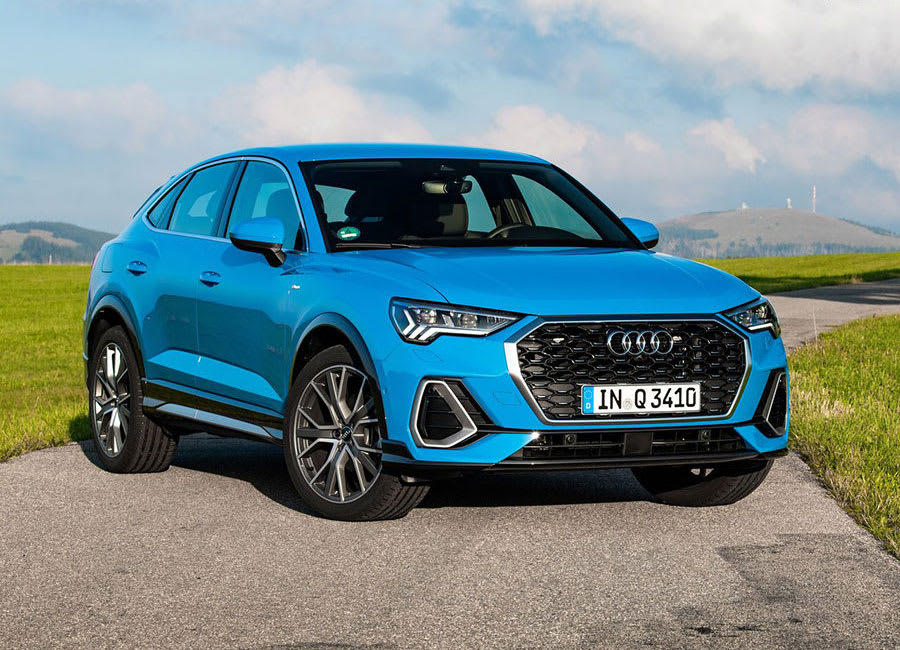
Like the regular Q3, there’s a choice of engines and trim levels. The power options range from fuel efficient and punchy to seriously powerful, and while all the trims are well kitted out, the higher-end models really ramp up the tech and extra features.
Key Features
Audi markets the Q3 as striking a balance between style, handling ability and cutting-edge technology, but the Q3 Sportback puts more emphasis on the style. The more rakish silhouette is inspired by coupe-style sports cars, and a sportier body kit gives it a more dynamic look.
Regular Q3 Sportback models have sports suspension as standard, while the top-spec Vorsprung trim has an adaptive system to give you the choice between stiff and soft. The high-end RS Q3 Sportback ups the excitement, with some serious horsepower under the bonnet and mechanical tweaks for extra sportiness.
As for tech, all models come with some very modern features including bright LED headlights and some clever safety systems, and these features get more impressive as you go up the trim levels.
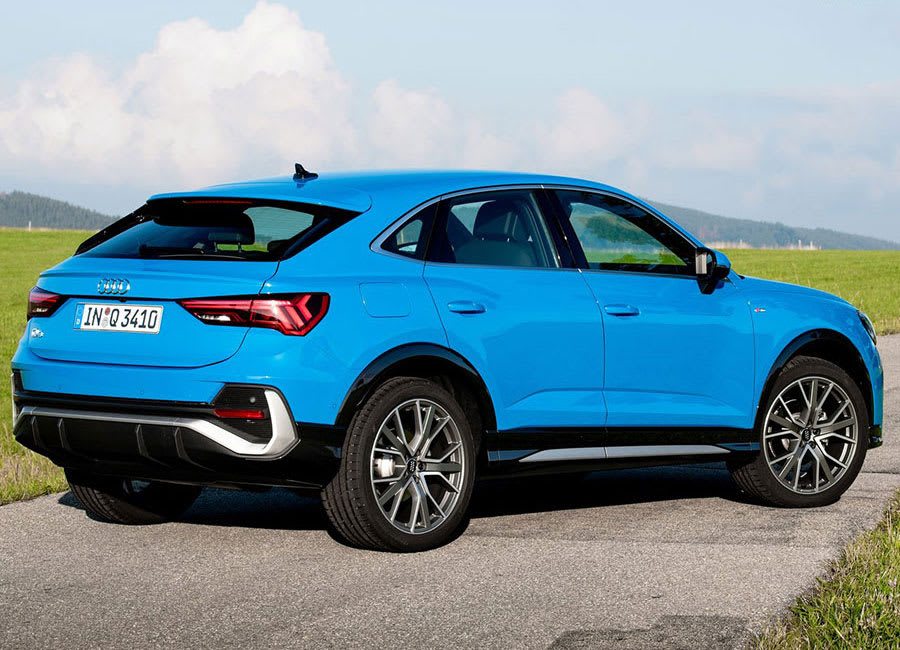
Customers can choose from a range of impressive petrol and diesel engines, but there’s no plug-in hybrid (PHEV) option, which is something that several of the Q3 Sportback’s rivals can boast.
Performance & Drive
Exactly what the Q3 is like to drive will depend on which model you go for, because aside from the engine differences, there are two different types of suspension setup. The standard suspension in the regular Q3 isn’t available, which means a slightly firmer ride, but improved handling. The comfort level is entirely acceptable, but you’ll feel bad road surfaces beneath you more than you would in the non-Sportback model.
Top-spec Vorsprung models come with a clever adaptive suspension setup, which can change the stiffness depending on conditions. It’s the best setup, but you’ll pay quite a bit extra for it.
The steering is light enough to make for easy manoeuvering around town, but weighty enough to give confidence through the corners. It does lack a bit of feel though, and so doesn’t feel particularly engaging in comparison to the BMW X2, and it’s not much of a step forward from the regular Q3 fitted with the same suspension.
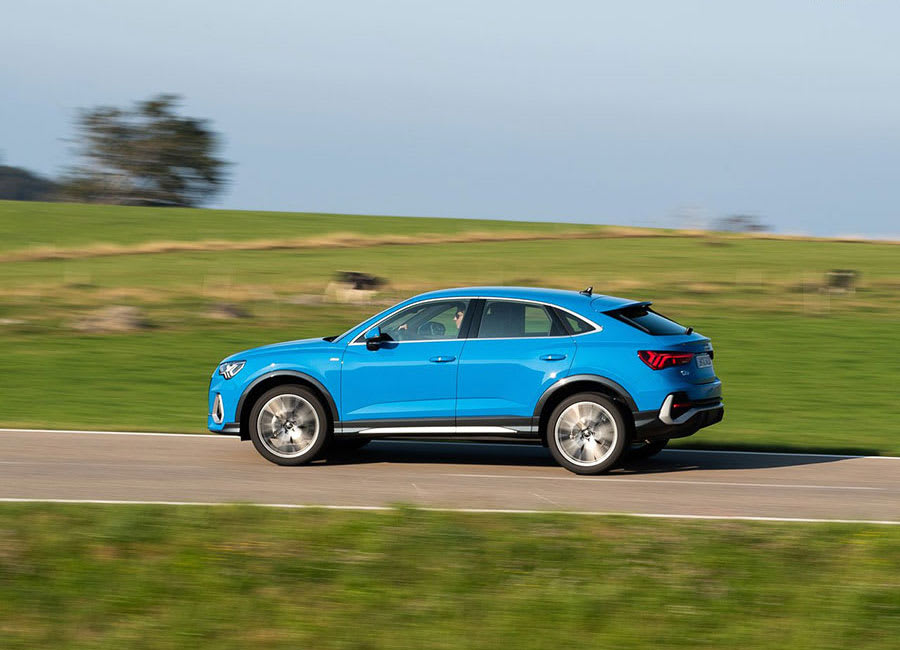
The performance RS Q3 model has specific RS suspension that’s been set up to be extra-sporty. That means it’s very stiff to keep it stable around the corners, but that does mean a harsh ride that some might find too much for everyday use. We’d upgrade to the optional adaptive suspension, but that will add even more to the already-substantial premium that the RS commands over the other models.
Petrol engine choices start with the 148bhp 1.5-litre unit, badged as the 35 TFSI. It’s available with either a six-speed manual gearbox or a seven-speed automatic, and in front-wheel drive only. For many people, this will be more than enough power to pootle around town, although it does sometimes need working hard if you want to get up to faster speeds, for example on the motorway.
Next up is the 40 TFSI, a 2.0-litre engine with 187bhp, all-wheel drive (which Audi calls Quattro) and an automatic gearbox. The 45 TFSI ups that to 242bhp. Both of these feel noticeably more effortless than the 35 TFSI, and the extra grunt is nice to have, but if you’re not fussed about acceleration then they’re not an essential upgrade, especially as the addition of all-wheel drive has an impact on fuel economy. The automatic gearbox can also be a bit hesitant, sometimes erring on the side of fuel economy rather than performance in its choice of gear.
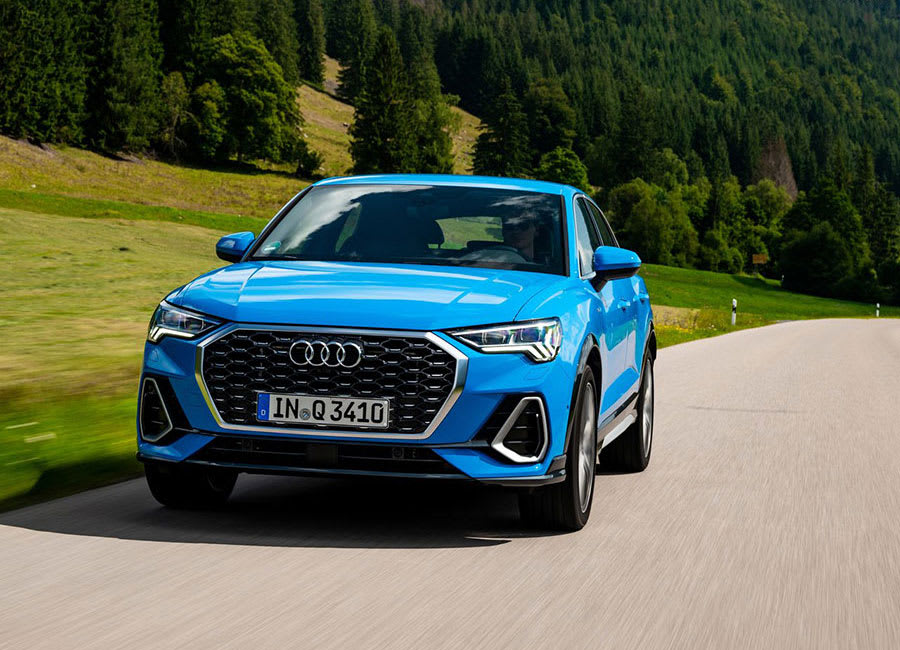
If you want your Q3 Sportback to have a bit more fire in its belly, then the RS Q3 Sportback could be for you. Under its bonnet is a five-cylinder, 2.5-litre petrol engine with 395bhp. That means scintillating acceleration, and it’s tremendously fast, but again lacks that final level of engagement for the driver, which is especially important in a performance-focused model.
On the diesel front, the 35 TDI is a 2.0-litre engine with 148bhp, available with a manual gearbox in front-wheel drive or the automatic in front-wheel drive or all-wheel drive. This is a sensible choice if you do lots of longer journeys, as the higher price of diesel at the pump could be offset by improved fuel economy over petrol. It’s not the punchiest performer but, again, it’ll be fine for a lot of people. If you do want extra poke, the 40 TDI has 197bhp and Quattro, and is automatic-only. This gives you extra oomph and doesn’t lose much fuel economy compared to the 35 TFSI Quattro, but will cost you more each month.
Not all models are available with all the engine choices, with more powerful engines generally the preserve of the higher trim levels.
Running Costs & Emissions
You’ll pay a bit of a premium when leasing a Q3 Sportback, compared to a Q3, which reflects the purchase prices were you to buy one. You’ll also pay a bit more than you would for an equivalent BMW X2, but a chunk less than for a Range Rover Evoque.
When it comes to fuel costs, the Q3 Sportback suffers from the lack of a plug-in hybrid model, which is something that rivals like the X2 and Evoque can offer. Fuel economy figures are most impressive in the diesels, with the front-wheel drive 35 TDI promising up to 55mpg according to official figures. That’ll dip with all-wheel drive models to up to 47.9mpg. The Quattro 40 TDI will give you up to 45.6mpg.
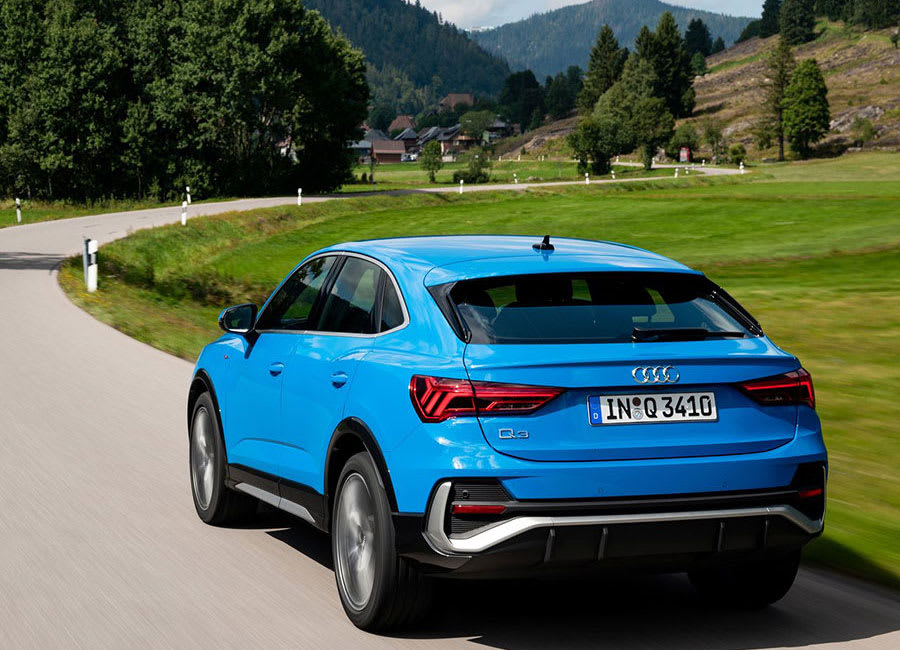
On the petrol side, the 35 TFSI manual promises up to 43.5mpg. The 40 TFSI Quattro dips the economy down to 36.7mpg, and the 45 TFSI Quattro to up to 32.8mpg. The RS Q3 very much favours performance over fuel economy, and officially consumes up to 29.4mpg.
Insurance groups start at 23 and rise to 40 of 50, depending on model, which means premiums get more expensive the more powerful and better-equipped the Q3 you go for. With no plug-in hybrid or full electric model in the Q3 Sportback range, the diesels make for the best options when it comes to benefit-in-kind company car tax. The front-wheel drive 35 TDI with a manual gearbox emits between 134 and 152g/km of CO2, which puts it in the 32% to 34% tax brackets for 2021/2022. In comparison, the automatic 35 TDI Quattro emits between 155 and 163g/km (35% or 36%). The petrol-powered 35 TFSI emits between 148 and 160g/km, putting it in the 33% to 36% brackets. All other models are in the maximum 37% bracket.
Interior & Technology
Audi has an enviable reputation for producing cars with beautiful interiors, in terms of design, build quality and material use. The Q3 Sportback’s cabin is virtually identical to its non-Sportback sibling, and mostly keeps that reputation going. That said, compared to Audi’s lofty benchmarks it’s not one its best, with a few cheap-feeling materials to be found if you look closely. Still, it’s far more of a luxurious environment than more mainstream models.
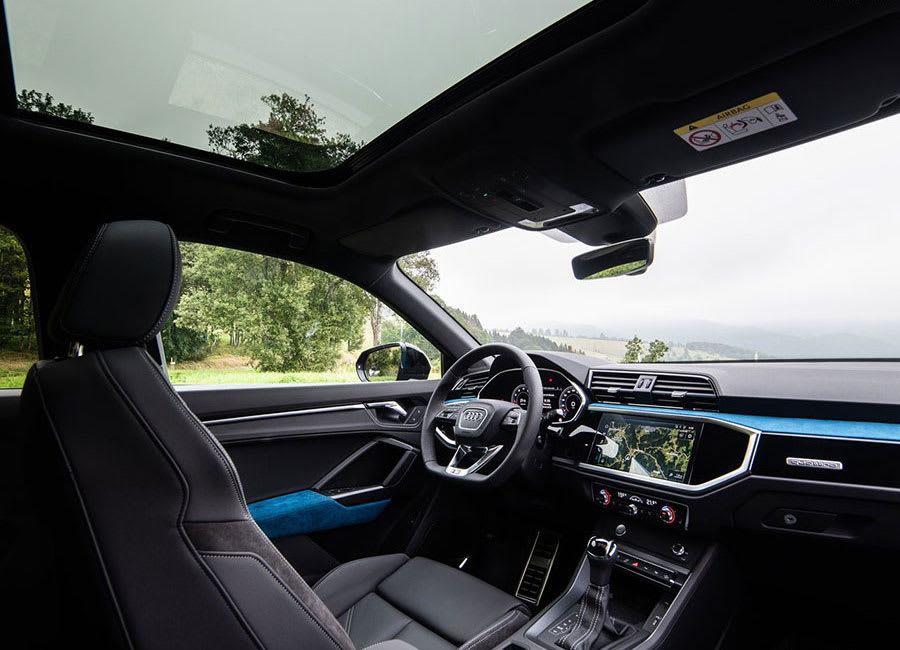
There’s loads of adjustment in steering column and seat height to ensure you can find your favourite driving position, although if you have a bad back it’s worth pointing out that lumbar support adjustment is only available on the very top-spec cars. Audi’s touchscreen infotainment system is included on all models, with a big 10.1-inch screen that looks great. It includes Apple CarPlay and Android Auto for smartphone connectivity, and sat-nav that can be setup to use aerial photography on the maps, which looks fantastic and can be useful when trying to find a new destination.
If there’s a quibble with it, it’s that touchscreen-only systems are harder to use on the move than those with separate controllers. BMW’s iDrive system, for example, uses a central dial that’s easier to use without having to take your eyes off the road.
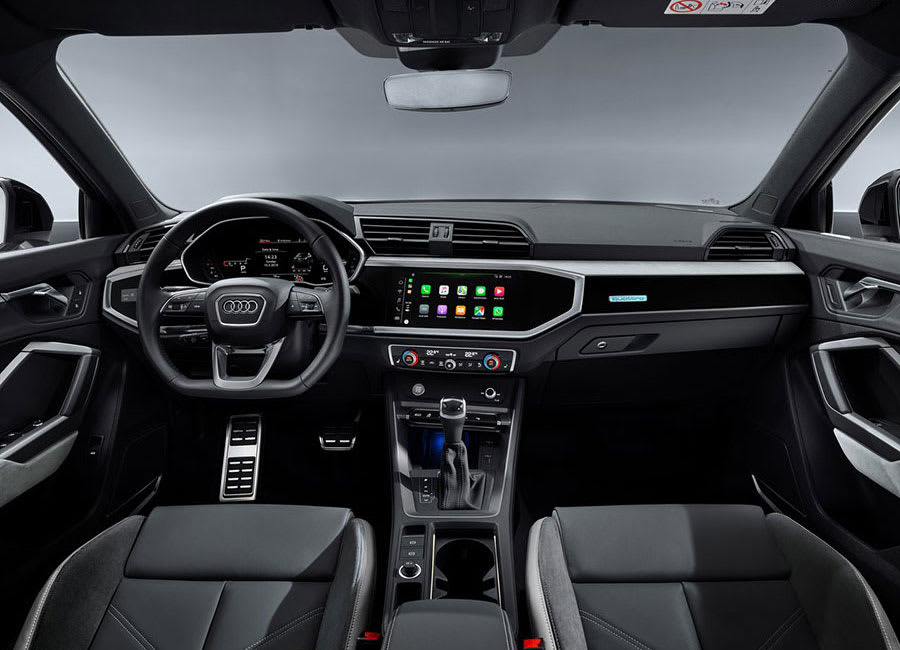
All models also get a Virtual Cockpit, which is Audi’s name for the screen behind the steering wheel that replaces traditional analogue dials. This is a stylish and useful feature, allowing you to customise what information you want to see, from speed and fuel economy to sat-nav info and entertainment options.
Practicality & Boot Space
Space in the Q3 Sportback might be compromised over the standard Q3, but it’s still pretty good, with loads of room up front and decent, if not spectacular capacity for passengers in the back. Tall rear passengers beware though; the sloping roofline means headroom is tight, and even more so if you have a model with a sunroof. You’ll get more room in the rear seats of an Evoque, but you won’t get the ability to recline the rear seats, which the Q3 Sportback can do. They’ll slide back and forward to increase legroom too, at the cost of a bit of boot space.
That boot, by the way, is up to 530 litres in volume, which is less than the regular Q3 and the Evoque, but bigger than the X2. The rear seats fold in a 40/20/40 split to offer space for larger items, which is much more flexible than the usual 60/40 configuration offered by some rivals.

The door pockets are a good size, and there’s a storage tray in front of the gearstick, two cup holders between the front seats and a good-sized storage box under the centre armrest.
Safety
The regular Audi Q3 was tested by independent safety organisation Euro NCAP in 2018 and scored the maximum five stars, with particularly impressive scores for adult safety. All models come with some of the latest active safety systems, including automatic emergency braking, a lane departure warning system and a connected feature that will help guide you back into your lane if you inadvertently veer out of it.
All models also get six airbags and Isofix child seat mounting points on the outer rear seats and front passenger seat.
Options
The Q3 Sportback range starts with the Sport, which includes features like bright LED headlights, 18-inch alloy wheels, sports seats and the full infotainment system with sat-nav.
S line cars have 19-inch alloys with sport suspension and part-leather upholstery inside, as well as tinted rear windows and an ambient lighting pack, for a snazzier interior look at night. Meanwhile Black Edition cars have special matt titanium-look 19-inch wheels, black elements rather than chrome on the outside, and piano black inlays inside.
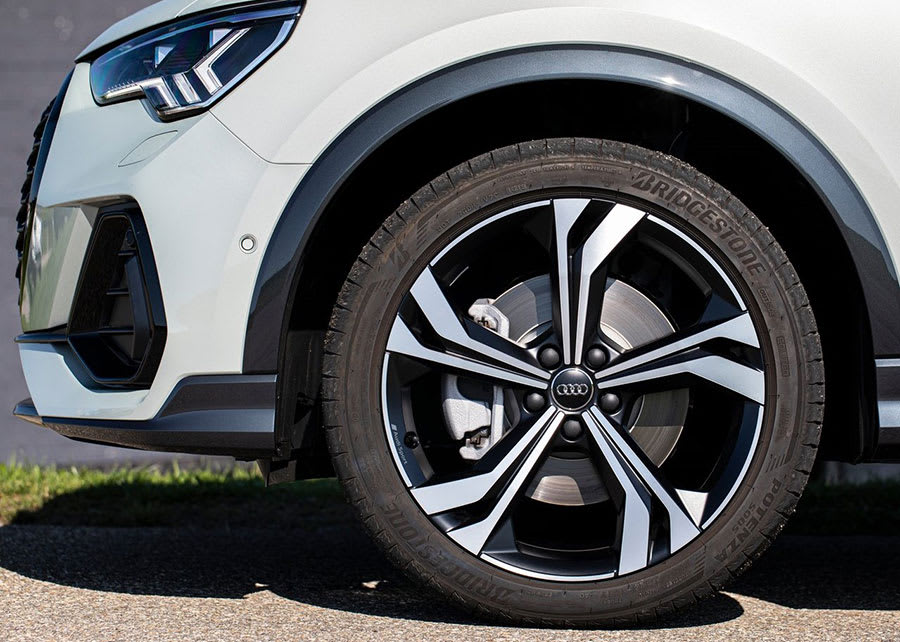
The top-spec Vorsprung model rides on 20-inch wheels and adaptive suspension. It also has clever Matrix LED headlights, which let you keep high beam on at night without dazzling oncoming traffic. There’s also a panoramic sunroof and Bang & Olufsen sound system, as well as adaptive cruise control.
The RS Q3 Sportback comes in standard form, with 20-inch alloys, Audi Sport Edition with black 21-inch wheels and a sports exhaust, and Vorsprung, with a black styling pack and carbon effect side mirrors.
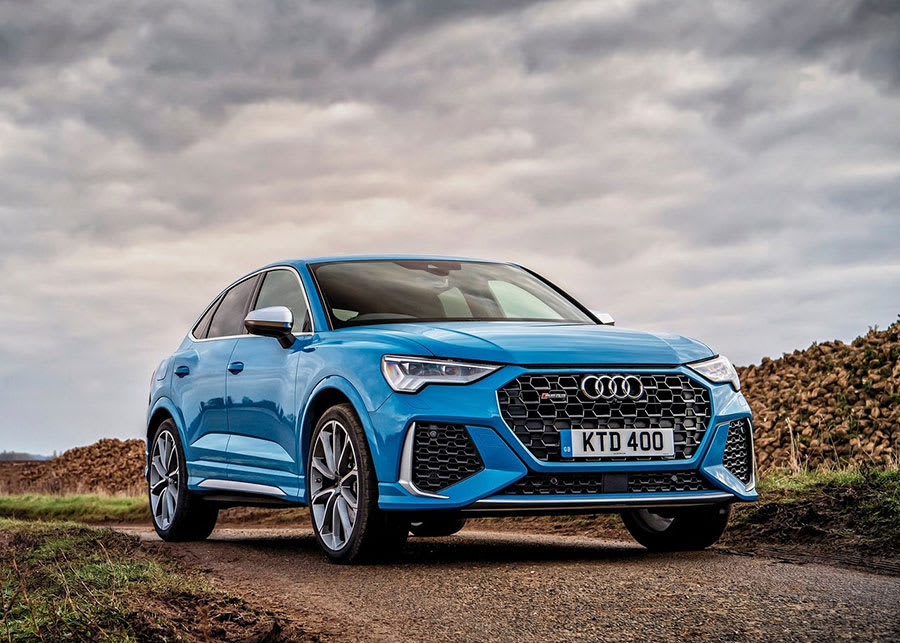
Options range from the B&O sound system and heated front seats to metallic paints and leather upholstery.
Rival Cars
With virtually all manufacturers offering small SUVs these days, and plenty of them giving coupe-SUV variants, there’s no shortage of premium rivals for the Q3 Sportback range.
You might also want to look at BMW’s X2 and the Mercedes GLC Coupe. The BMW is more fun to drive than the Audi, but it has less space inside. The Mercedes is larger and more expensive. However, the availability of a plug-in hybrid model could be a big draw, especially for company car drivers. The Range Rover Evoque and X2 are also available as PHEVs, so the lack of one is a big drawback for the Q3. Should you need to take your small SUV off road, then the obvious choice is the very capable Evoque, although it’s another rival that can be pricey.
Verdict & Next Steps
The appeal of the Q3 Sportback will depend on whether your leasing decision is ruled by your heart or your head. There’s a strong argument that it’s a more attractive purchase than the regular Q3, but the sensible part of your brain will be whispering to you that you’ll pay more for less space. If logic wins, then the Q3 is a better bet, but if you want to look back at your car each time you leave it and smile, then the Sportback is more likely to catch your eye. Both versions have high quality interior and a range of different trim and engine choices, but they lack a PHEV option and the Sportback is not the most exciting car of its type to drive. However, we doubt anyone will be upset with their choice, as overall, it’s a very accomplished car.
Where to next?
View latest Audi Q3 Sportback leasing deals- guide price from £326.39 per month inc VAT**
Looking for a great leasing deal? Check out our incredible range of car lease deals
New SUV? Read our latest Reviews and find the right model for you
Want to know more about leasing? Take a look at our comprehensive Leasing Guides
Interested in everything motoring? Why not catch up on all the latest Car Leasing News.
*Score based on Select’s unique meta score analysis, taking into account the UK’s top five leading independent car website reviews of the Audi Q3 Sportback
**Correct as of 30/06/2021. Based on 9 months initial payment, 5,000 miles over a 48 month lease. Initial payment equivalent to 9 monthly payments or £2,937.49 Ts and Cs apply. Credit is subject to status.





















